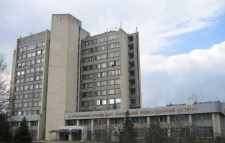
|
National Science Center Kharkov Institute of Physics and Technology |
 HomeHistoryPublicationsConferences
HomeHistoryPublicationsConferences
|
|
|
|
|
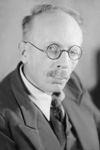 |
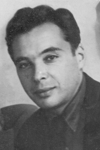 |
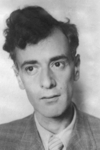 |
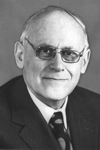 |
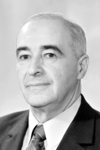 |
|
Ivan V. Obreimov
|
Dmitry D. Ivanenko
|
Lev D. Landau
|
Alexander I. Akhiezer
|
Ilya M. Lifshitz
|
When in the early 1990s in a difficult economic situation the KIPT had to be reorganized, A.I. Akhiezer was an ardent supporter of a separate institute for theoretical physics, being a constituent of a newly created National Science Center KIPT. By this time his department was headed by his disciple S.V. Peletminsky. Alexander Ill’ich Akhiezer did everything possible for formation of the Institute for Theoretical Physics and to subordinate the National Science Center KIPT to the National Academy of Sciences of Ukraine. In 1996 the part of his plan was realized and the Institute for Theoretical Physics was established. The NSC KIPT was affiliated with the National Academy of Sciences of Ukraine in 2004, already after the death of A.I. Akhiezer.
In 2003 a decree of the Ukrainian Cabinet gave the name of academician of the National Academy of Sciences A.I. Akhiezer to the Institute for Theoretical Physics of NSC KIPT.
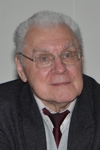
|
Since the establishment of the ITP NSC KIPT in 1996 its first director was Professor Nikolai Fedorovich Shulga. While holding this post, he was elected as a Corresponding Member of the NAS of Ukraine in 2003. Six years later, he became a full member of the NAS of Ukraine, in 2015 he was elected Academician-Secretary of the Department of Nuclear Physics and Energy, and since 2016 he has headed NSC KIPT as Director General. Remaining in this post until his death in January 2024, N.F. Shulga actually headed the ITP, was the chairman of the Academic Council of the Institute for Theretical Physics, while formally being the Scientific Superviser of the ITP. |
| Nikolai F. Shulga |
Lines of research at ITP
Fundamental researches in:
- supersymmetry and supergravitation theories and cosmology;
- quantum field theory and elementary-particle physics;
- nuclear physics and nuclear reactor physics;
- theory of interaction of high-energy particles with matter;
- statistical physics;
- solid-state physics and physics of radiation damage.
Main results of recent years
Supersymmetry and supergravitation theories and cosmology
A concept of supersymmetry was proposed, on the basis of which the notion of Goldstone fermions with spin 1/2 was introduced. The idea of superspace was proposed and the first theory of supergravity was constructed, which predicted gravitino field with spin 3/2 and a supersymmetric generalization of the Higgs effect.
Studied was unification of the Penrose twistor approach with supersymmetry for constructing new models of superparticles, superstrings, and superbranes, their covariant quantization, and their application as a basis for formulating quantum theory of gravity.
A gauge realization of the model of Universe as a p-brane hypersurface was proposed. A new mechanism of the spontaneous generation of gravity was found, in which the Newton constant is determined by mean curvature of the brane hypersurface.
Based on the formalism of supersymmetric field theories new duality-symmetric models of supergravity and string theory were constructed, new solutions to the Einstein's equations with matter fields were established, and various aspects of the gauge/gravitational duality were studied within the effective hydrodynamic description of relativistic media at a strong coupling constant.
Within the framework of the earlier proposed extended supersymmetric quantum mechanics a procedure of constructing exactly solvable models with multi-well potentials was developed and used for the theoretical analysis of real physical processes.
A cosmography of a wide class of cosmological models was constructed. The influence of the interaction in the dark sector on the dynamics of the universe was investigated.
Quantum field theory and elementary-particle physics
With the help of the relativistic Dirac wave equation, the properties of a massive neutral particle with zero spin as a candidate for dark matter were investigated. Within the Hamiltonian formalism of the relativistic quantum field theory, an algebraic approach was developed to ensure relativistic invariance, taking into account noncovariant and nonlocal contributions to the interaction Hamiltonian of elementary particles.
An approach was developed for description of the intermediate-energy deuteron scattering on the alpha-cluster nuclei and an analysis of experimental data on the cross sections and polarization observables for these processes was performed.
Theoretical approach has been developed for description of rare decays of heavy B-mesons. Decays of the Higgs boson into photon and Z-boson, into photon and lepton pair, as well as decay into two off-mass-shell Z-bosons have been developed.
Theoretical approach has been proposed for determining magnetic and electric dipole moments of the short-lived baryons containing the charm c-quark. Feasibility of measuring these quantities in experiments using bent crystals at the Large Hadron Collider (LHC) at CERN has been investigated.
Covariant approach for calculation of the radiative corrections to the polarization observables in the elastic and deep inelastic electron scattering on nucleons and deuterons has been developed.
Contribution from the non-resonant mechanism in the process of electron-positron annihilation into nucleon, antinucleon and pi-meson in the wide interval of energies has been calculated.
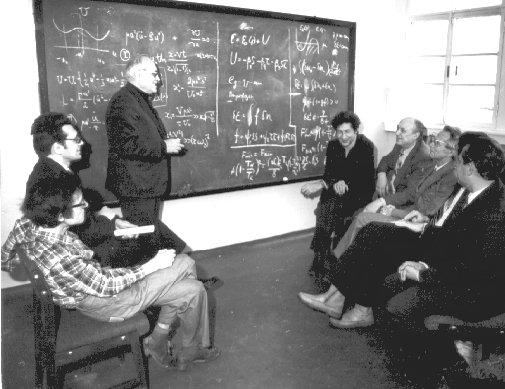 |
 |
|
Theoretical seminar, 1986. At the blackboard - A.I.Akhiezer.
|
Theoretical seminar, 2003.
|
Nuclear physics and and nuclear reactor physics
Microscopic optical potentials were built for the description of the interaction of nucleons, deuterons, and alpha-particles with atomic nuclei in a unified self-consistent approach together with the description the nuclear matter and the structure of finite nuclei.
An analysis of properties of the even-even extremely neutron-rich nuclei was performed with allowance for the axial deformation of nuclei, and it was shown that peninsulas of nuclei that are stable relative to the emission of one or two neutrons can exist beyond the previously theoretically known neutron drip line.
A theory of the phenomenon of slow nuclear burning in a multiplicative environment was developed. The physical foundations of a promising concept of a fast reactor operating in a self-sustaining nuclear burning wave mode were developed. A special mechanism of negative feedback with reactivity was discovered and studied in detail, which ensures the stability of the nuclear burning wave regime with respect to various types of neutron field disturbances in the reactor.
A set of computer codes FANTENS-2D was developed for numerical solution of the non-stationary nonlinear neutron diffusion equation in a multiplicative medium and modeling of transient processes in a reactor with a nuclear burning wave. A method for controlling the power of such a reactor without the use of absorbing rods was proposed.
Theory of interaction of high-energy particles with matter
A quasiclassical theory of the processes of coherent scattering and emission of high-energy charged particles in oriented crystals under conditions of a large effective coupling constant has been developed. The effect of suppression of bremsstrahlung of ultrarelativistic electrons in thin layers of amorphous and crystalline matter (Ternovsky-Shulga-Fomin effect) has been predicted.
A stochastic mechanism for the deflection of high-energy particle beams using curved crystals is proposed, which is based on the process of multiple scattering of particles on chains of atoms (the Grinenko-Shulga mechanism). The possibility of splitting a beam of positively charged particles into several beams when passing through a curved crystal of axial orientation is envisaged. These results were confirmed in experiments at the CERN SPS. An analytical theory of the volumetric reflection of high-energy charged particles in bent crystals of planar orientation was developed.
The theory of ionization energy loss, transient and coherent X-ray radiation of relativistic "semi-naked" electrons in thin amorphous and crystalline targets was developed. The quantum theory of coherent effects in ionization energy loss of ultrashort electron bunches in thin solid-state targets and gases has been developed. For beams with periodic density modulation, the effect of resonant increase in ionization losses is predicted.
The relationship between the differential cross section of scattering of fast charged particles on atoms and the Periodic Table of Elements in the form of "left steps" was established. A method for reconstructing a single-photon spectrum from a multi-photon spectrum was formulated. The limiting distributions of energy losses to radiation during channeling were obtained with increasing crystal thickness and average number of emitted photons.
Statistical physics
The problem of determination of the non-equilibrium entropy of interacting particles was solved. The microscopic theory of irreversible processes in condensed systems with the spontaneously broken symmetry was advanced. A Fermi-liquid approach to superfluid liquids was developed, that was applied to the study of equilibrium and kinetic properties of superconductors. A statistical approach to problems of classification of equilibrium states in condensed media with the spontaneously broken symmetry was developed with the application to the analysis of equilibrium states with vector and tensor order parameters.
A method of the reduced description of macroscopic non-equilibrium fluctuations was developed. Kinetic and hydrodynamic theories of long-wavelength fluctuations were constructed in microscopic approach on the basis of this method. A number of applications in the turbulence theory, in "the long hydrodynamic tails" theory, and the quasilinear theory of plasma were examined.
New formulation of the method of secondary quantization in the presence of bound states of particles was proposed.
Microscopic theory of the interaction of ultracold quantum gases with electromagnetic field was constructed. Conditions for controlling the speed of light in Bose condensates, including phenomena of signal deceleration and stopping, were determined, and a mechanism of electromagnetic waves filtering was proposed.
Collective effects and manifestations of spontaneous symmetry breaking in quantum many-particle systems of interacting particles, such as high-spin gases, lattice Hubbard models, Bose condensates of various physical nature, and superfluid quantum crystal (supersolid), were investigated.
A theory of the first passage for Markovian Lévy processes with drift was constructed. The effects of anomalous diffusion in a medium with strong spatiotemporal fluctuations were investigated.
Solid-state physics and physics of radiation damage
A polycluster model of amorphous solids was constructed; and the thermodynamic, kinetic, and mechanical properties of polycluster metallic glasses were described. The Kolmogorov-Johnson-Mehl-Avrami theory of phase transformations was generalized to the case of a bounded system. The problem of strength and sliding of a disordered atomic layer with an arbitrary distribution of local critical stresses, which has an application to the description of the mechanical properties of amorphous materials, was solved analytically.
The evolution of the phase composition of binary alloys under irradiation was described. A theory of the radiation-induced vacancy swelling of quasicrystals was constructed taking into account the kinetics of phasons of vacancy and interstitial types.